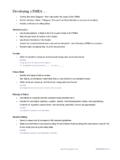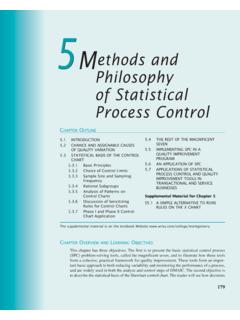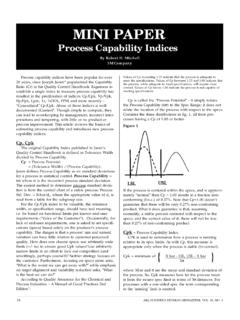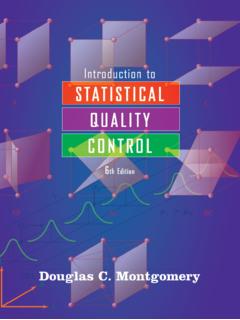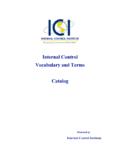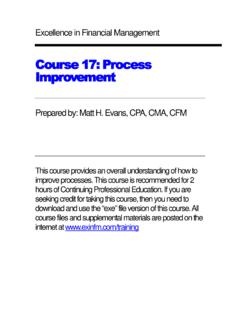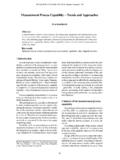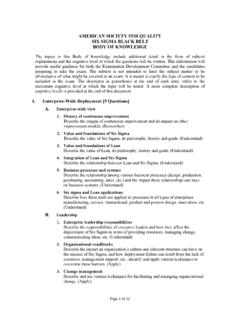Transcription of The Philosophy of TQM An Overview - The Quality Portal
1 1 Eng. 401: total Quality ManagementCourse Notes: TQM Philosophy -An OverviewHammettU. of MichiganThe Philosophy of TQM An OverviewReferences for Lecture:Background Reference Material on Web: The Philosophy of TQM by Pat HammettTQM = Customer-Driven Quality ManagementCustomer Quality MeasuresCustomers typically relate Quality to:1)Feature-based measures ( have or have not )ndetermined by designndiamond example: marquise shape diamond vs. round diamond2) Performance measures ( range of values )nconformance to design or ideal valuendiamond example: 4Cs --carat, clarity, color, cutIn this class, we will focus more on analyzing performance 401: total Quality ManagementCourse Notes: TQM Philosophy -An OverviewHammettU. of MichiganWhat are the Different Views of Quality ?nCustomer s View (more subjective view): nquality of the design (look, feel, and function).nconsider both feature and performance measures to assess valuenValue = Quality / Price (value determined by individual customers)nProducer s View (more objective view):nconformance to requirements (term coined by Philip Crosby).
2 , # of defects per million products is a measure of of Quality (prevention, appraisal, scrap & warranty costs).nprevention costs: training, writing Quality proceduresnappraisal costs: inspecting and measuring product characteristicsnscrap and rework costs: internal costs of defective productsnwarranty costs: external costs for product failures in the fieldnincreasing Quality conformance reduces product costs and raises of Quality Paradigms (producer / customer relationship)nCustomer-craft Quality paradigm: ndesign and build each product for a knows the customer production and inspection Quality paradigm:nfocus on designing and building products for mass consumption. npush products on the customer (limit customer choices).nquality is maintained by inspecting and detectingbad innovation to this paradigm: statistical process control nTQM or Customer-Driven Quality paradigm:npotential customers determine what to design and Quality obtained by focusing on preventingproblems and continuously reducing variability in all organizational 401: total Quality ManagementCourse Notes: TQM Philosophy -An OverviewHammettU.
3 Of MichiganThe Quality Hierarchy (Evolution)1. Inspection2. Quality control (QC)3. Quality Assurance (QA)4. total QualityManagementinspect &Fixing Mistakes(REACTIVE)operational techniques to make inspection more efficient & to reducethe costs of Quality . (example: SPC)planned and systematic actions toinsure that products or services conform to company requirements(example: reliability analysis). incorporates QC/QA activities intoa company-wide system aimed atsatisfying the customer.(involves all organizational functions)Preventionstop problems at source; greaterdesign emphasis(PROACTIVE)TQM DefinedTQM is a management Philosophy which seeks to integrate all organizational functions (marketing, finance, design, engineering, production, customer service ..) to focus on meeting customer needs and organizational objectives. It views organizations as a collection of processes. It maintains that organizations must strive to continuously improve these processes by incorporating the knowledge and experiences of workers.
4 4 Eng. 401: total Quality ManagementCourse Notes: TQM Philosophy -An OverviewHammettU. of MichiganThe Simple Objective of TQM Do the right things, right the first time, every time. Some Basic Tenets of customerdetermines Quality requires the establishment of effective Quality metrics. We must speak with data not just within systemscreate Quality . is a moving target. It requires a commitment toward sustainedcontinuous not detectionis the key to producing high Quality . We must design Quality into products and reduce variability. management must provide leadership and support for all Quality initiatives. 5 Eng. 401: total Quality ManagementCourse Notes: TQM Philosophy -An OverviewHammettU. of MichiganAPPENDIX:Innovators of Modern Quality Quality Innovators and the Main Years of their Work:nWalterShewhart (1920s -1940s)nW. Edwards Deming (post WWII through 1980s)nJoseph (consultant post WWII through 1980s)nPhilip Crosby (1980s)nArmandFeigenbaum(1970s -1980s)Japanese Quality Innovators:nKaoru Ishikawa (post WWII -1980s)nGenichiTaguchi (1960s -1980s)nShigeo Shingo (post WWII -1980s)Walter AShewhartnPioneer of Modern Quality Controlnrecognized the need to separate variation into assignable andunassignablecauses (defined in control .)
5 N founder of the control chart ( X-bar and R chart).noriginator of the plan-do-check-act the first to successfully integrate statistics, engineering, and Quality in terms of objective and subjective Quality nobjective Quality : Quality of a thing independent of Quality : Quality is relative to how people perceive it. (value)6 Eng. 401: total Quality ManagementCourse Notes: TQM Philosophy -An OverviewHammettU. of MichiganW. Edwards DemingnStudied underShewhartat Bell LaboratoriesnContributions:nwell known for helping Japanese companies applyShewhart sstatistical process Contribution is his Fourteen Points to Quality (some key points below)ncreate constancy of mass production -build Quality into out fear and build employee down departmental barriers (create win-win situations).nseek long-term supplier relationship (end low cost bidding).neliminate numerical goals; abolish annual rating or merit slogans -they provide no value in terms of improving Deming Chain Reaction(proposed W.)
6 Edwards Deming)ImproveQualityCosts decrease:(less rework,fewer mistakes,better use of materialand equipment)ProductivityImprovesGreater MarketShare (products with higher Quality at less cost)StayInBusinessProvide Jobsand More Jobs7 Eng. 401: total Quality ManagementCourse Notes: TQM Philosophy -An OverviewHammettU. of MichiganJoseph well-known for helping improve Japanese most of his work at executives and the field of qualitymanagement. ndeveloped theJuran Triologyfor managing Quality :nQuality planning, Quality control , and Quality the world on the concept of the vital few, trivial manywhich is the foundation US Quality InnovatorsnPhilip Crosby ( Quality management )nFour absolutes of Quality including:n#1- Quality is defined by conformance to #2 -system for causing Quality is prevention not #3 -performance standard is zero defects, not close #4 -measurement of Quality is the cost of nonconformancenArmandFeigenbaum nStressed a systems approach to Quality (all organizations must be focused on Quality )nCosts of Quality may be separated into costs for prevention, appraisal, and failures ( , scrap, warranty).
7 8 Eng. 401: total Quality ManagementCourse Notes: TQM Philosophy -An OverviewHammettU. of MichiganKaoru Ishikawandeveloped concept of true and substitute Quality characteristicsntrue characteristics are the customer s viewnsubstitute characteristics are the producer s viewndegree of match between true and substitute ultimately determines customer of the use of the 7 tools ( , cause-and-effect diagram)nadvanced the use of Quality circles (worker Quality teams).ndeveloped concept of Japanese total Quality Controlnquality first -not short term process is your facts and data to make for humanity as a management Philosophy -full Quality InnovatorsnGenichiTaguchi (1960s -1980s)nquality loss function (deviation from target is a loss to society).nPromoted the use of parameter design (application of Design of Experiments) or robust Shingo (post WWII -1980s)nadvocated the replacement of statistical process control with source inspection( control Quality at the source, rather than through sampling inspections).
8 Nset up poke-yoke devices (mistake proofing devices) such as sensors and monitors to identify defects at the point they to his system as a zero defect approach because Zero Defects is the ultimate goal.
